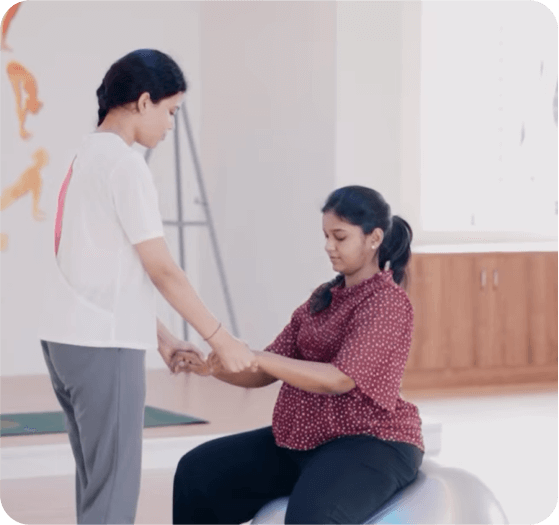
Our Prenatal/Postnatal Training program is designed to support women through all stages of pregnancy and postpartum recovery. This specialized yoga practice focuses on nurturing the body and mind, promoting relaxation, and ensuring a healthy transition during and after pregnancy. Whether you’re an expectant mother preparing for childbirth or a new mom recovering and reconnecting with your body, this program offers safe, gentle, and effective practices tailored to your unique needs.







Prenatal and Postnatal Training are exercise programs designed specifically for women during and after pregnancy. Prenatal training focuses on safe exercises to support the body through pregnancy, while postnatal training helps new mothers regain strength, stability, and mobility after childbirth. Both programs aim to improve overall fitness, reduce discomfort, and support recovery and well-being.
Yes, it is generally safe to exercise during pregnancy, but the key is to choose exercises that are appropriate for your stage of pregnancy and physical condition. Prenatal training focuses on low-impact, safe exercises that support the body’s changes. Always consult with your doctor before starting any exercise program, especially if you have any pregnancy-related complications or conditions.
Prenatal training offers several benefits, including:
Safe exercises during pregnancy include:
Avoid exercises that involve lying on your back after the first trimester, high-impact activities, or any exercises that could lead to balance issues or falls.
It’s important to wait until you receive clearance from your healthcare provider, usually around 6 weeks postpartum for vaginal deliveries or longer if you had a C-section or complications. However, gentle pelvic floor exercises, such as Kegels, can often be started earlier, depending on your recovery. Your trainer can help tailor exercises that support your healing process.
Postnatal training aims to:
Yes, strength training is generally safe and beneficial during pregnancy and postpartum, as long as it’s done with proper form and intensity. During pregnancy, the focus is on lighter weights and functional movements that support your changing body. After childbirth, strength training can help rebuild muscle strength, especially in the core, back, and pelvic floor. Your trainer will guide you on modifications to ensure safety.
Yes, but you may need to modify your approach to exercise, especially in the early stages of recovery. After a C-section, it’s crucial to wait for medical clearance before starting more strenuous exercises. Focus on gentle core and pelvic floor exercises initially. Over time, you can gradually introduce strengthening and functional movements, but it’s important to listen to your body and progress at your own pace.
Postnatal training, especially pelvic floor exercises like Kegels, can help improve muscle tone and function in the pelvic floor after childbirth. Strengthening these muscles helps reduce symptoms like urinary incontinence, pelvic organ prolapse, and sexual dysfunction. A trainer experienced in postnatal recovery can guide you through exercises that are safe and effective for strengthening your pelvic floor.
While weight loss isn’t typically the primary focus of prenatal and postnatal training, exercise can certainly help you regain strength, improve energy levels, and support healthy weight management. In the postnatal period, your body is recovering from pregnancy, so focus on building strength and getting your body back into a balanced state. Weight loss may occur gradually as you become stronger and more active.
Diastasis recti is a common condition during and after pregnancy where the abdominal muscles separate. It’s important to avoid exercises that put excessive pressure on the core, such as sit-ups or crunches. Postnatal training can include safe core exercises that help gently bring the abdominal muscles back together, focusing on proper alignment, strengthening the deep core muscles, and improving posture. A qualified trainer can design a program specifically for this condition.
Avoid exercises that could put you at risk for falls or injury, such as:
Always listen to your body and adjust the intensity as needed.
Yes, regular exercise can improve self-esteem and body image by helping you regain strength, energy, and a sense of control over your body. Prenatal and postnatal training is not just about physical recovery but also mental well-being. Exercise can help reduce stress, improve mood, and support a positive body image as you navigate the changes that come with pregnancy and motherhood.
Yes, it’s never too late to start! If you didn’t exercise during pregnancy, you can still benefit from safe and gradual prenatal or postnatal training. For postnatal training, your focus may start with gentle mobility exercises, strengthening, and improving flexibility. The key is to start slow and progress based on your comfort level and fitness, and to consult with your healthcare provider if you have any concerns.
During pregnancy, aim for at least 150 minutes of moderate-intensity exercise each week, which can be broken down into 30-minute sessions 5 days a week. Postpartum, the frequency depends on your recovery, but most women aim for 2-3 times per week initially, with the option to increase as strength and energy return. Always listen to your body and work with a trainer who can help guide you based on your fitness and recovery.
Our mission is to empower individuals of all ages and fitness levels to embark on a journey of self-discovery, inner peace, and physical strength.
Copyright © 2024 Ujjayi Yoga Fitness | All Rights Reserved | Made By Think Venky Studio
WhatsApp us